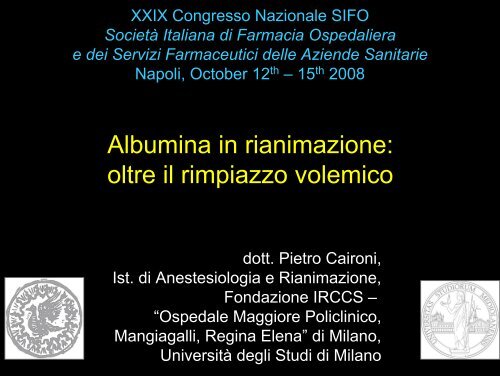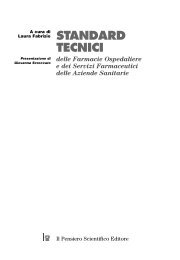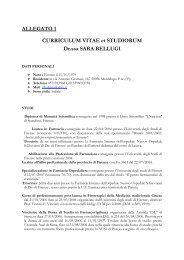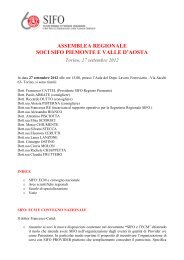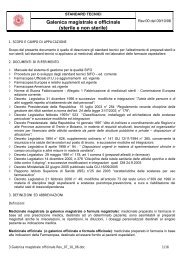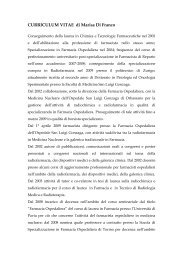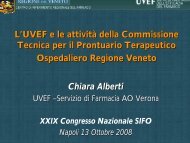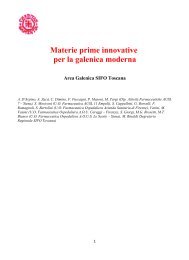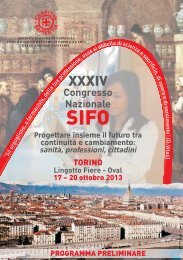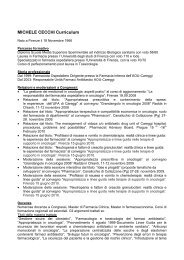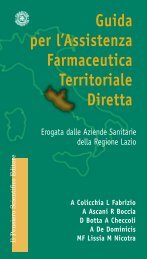Albumina in rianimazione: oltre il rimpiazzo volemico - Sifo
Albumina in rianimazione: oltre il rimpiazzo volemico - Sifo
Albumina in rianimazione: oltre il rimpiazzo volemico - Sifo
You also want an ePaper? Increase the reach of your titles
YUMPU automatically turns print PDFs into web optimized ePapers that Google loves.
XXIX Congresso Nazionale SIFOSocietà Italiana di Farmacia Ospedalierae dei Servizi Farmaceutici delle Aziende SanitarieNapoli, October 12 th –15 th 2008<strong>Album<strong>in</strong>a</strong> <strong>in</strong> <strong>rianimazione</strong>:<strong>oltre</strong> <strong>il</strong> <strong>rimpiazzo</strong> <strong>volemico</strong>dott. Pietro Caironi,Ist. di Anestesiologia e Rianimazione,Fondazione IRCCS –“Ospedale Maggiore Policl<strong>in</strong>ico,Mangiagalli, Reg<strong>in</strong>a Elena” di M<strong>il</strong>ano,Università degli Studi di M<strong>il</strong>ano
Why do we care for album<strong>in</strong>?Why do we need to care for album<strong>in</strong>?Medl<strong>in</strong>e on pubmed“album<strong>in</strong>”: 155.844 items“hemoglob<strong>in</strong>”: 125.396 itemslast 10 years (1998 – 2008):57.196 items [37 %]Everyth<strong>in</strong>g started dur<strong>in</strong>g the Wold War II:7 th december 1941, first case series of 7 patients verysever<strong>il</strong>y burned patients <strong>in</strong>jured dur<strong>in</strong>g the PearlHarbor attack
Actually, few months before,the first cl<strong>in</strong>ical use of human album<strong>in</strong> <strong>in</strong> traumatic shock“Office of Medical History” – http://history.amedd.army.m<strong>il</strong>/Case 4.—A 20-year-old man was admitted to Walter Reed GeneralHospital, Wash<strong>in</strong>gton, D.C., <strong>in</strong> May 1941, 16 hours after he had susta<strong>in</strong>edb<strong>il</strong>ateral compound comm<strong>in</strong>uted fractures of the tibia and fibula, fractures offive ribs; and associated pleural damage, pneumothorax, and subcutaneousemphysema. He was confused and irrational, with a blood pressure of 76/30mm. Hg. After he had been given two units of album<strong>in</strong> (each approximately25 gm.), over a 30-m<strong>in</strong>ute period, the pressure rose to 106/70 mm. Hg, andtwo hours later, after <strong>in</strong>sertion of a Kirschner wire, reduction of one of thefractures, and application of a cast, it was 130/80 mm. Hg. Over the next 12hours, the patient received 1,250 cc. of fluid by mouth and 1,000 cc. ofphysiologic salt solution subcutaneously. The systolic pressure rema<strong>in</strong>edabove 130 mm. Hg dur<strong>in</strong>g this period, with occasional elevations to 150 mm.Hg. There was no evidence of circulatory fa<strong>il</strong>ure at any time after theadm<strong>in</strong>istration of the album<strong>in</strong>.
Physiology and pathophysiologyOverview of evidences ava<strong>il</strong>ableRecent f<strong>in</strong>d<strong>in</strong>gs besides volume replacementand new cl<strong>in</strong>ical trials...
Album<strong>in</strong> structure - peculiaritiesMolecular weight: 66.500 Da.50% of plasmatic prote<strong>in</strong>responsible for 80%of oncotic pressureImportant characteristics for the critically <strong>il</strong>l:1) cyste<strong>in</strong> residuals – thiol groups2) dom<strong>in</strong>s I and II3) histid<strong>in</strong> – imadozole residuals
1) Oxygen radicals and NO scavengerSNONOS-nitrosylatedprote<strong>in</strong>SH S*GSHSSGreducedprote<strong>in</strong>S-thiolatedprote<strong>in</strong><strong>in</strong>termediateO 2SO 3 HO 2 radicals / NO
2) Metabolic transport functionsTyroidAdiposeFAMuscle(T4)PhospholipidsBoneCa 2+LIVERCysTrpSteroidsCysTrpFACu 2+Ca 2+B<strong>il</strong>irub<strong>in</strong>(Heme)AdrenalGutSpleen
3) Buffer functions – imidazole residualsGroup AH A - + H + pKGlu Asp -COOH -COO - H + 4.4LysArg-NH+3 -NH 2 H + 10HNH+H2 NH+2-N-C-N-CNH 2NH 2H + 12His-CH 2+HN HNnet fixed charge –21 mEq/mole-CH 2N HN H+ 6.516 imidazole residuals – buffer functionCys -SH -S - H + 8.5
Which functions are important for the critically <strong>il</strong>l?PrimaryOncotic propertiesSecondaryTransportAnti-oxydantNitric oxide modulationAcid base status
Indeed, two ma<strong>in</strong> questions:Hypoalbum<strong>in</strong>emia per se causes morbidity and/ormortality?Do we need to treat it?What is the best cure for hypoalbum<strong>in</strong>emia?
Physiology and pathophysiologyOverview of evidences ava<strong>il</strong>ableRecent f<strong>in</strong>d<strong>in</strong>gs besides volume replacementand new cl<strong>in</strong>ical trials...
From 1998 to 2003: The era of meta-analysis...Album<strong>in</strong> <strong>in</strong>fusionCochrane meta-analysis [1998]HarmfulW<strong>il</strong>kes’ meta-analysis [2001]IndifferentV<strong>in</strong>cent’s meta-analysis [2003]Beneficial
Po<strong>in</strong>t of view...Epidemiology:“Tomb of <strong>in</strong>tell<strong>in</strong>gence”Meta-analysis:“Sack<strong>in</strong>g of tombs”Reliab<strong>il</strong>ity of meta-analysis
… f<strong>in</strong>ally, a prospective randomized study.N Engl J Med 2004;350:2247-56
SAFE study – 2004Prospective, randomized, double-bl<strong>in</strong>ded trial16 ICU (Australia, New Zeland)Intravascular fluid resuscitation by 4% album<strong>in</strong><strong>in</strong>fusion (treated group) or sal<strong>in</strong>e NaCl 0.9% <strong>in</strong>fusion(control group)6997 patientsTreated group: 3497 patientsControl group: 3500 patientsPrimary outcome:death from any cause at 28-day period after randomization
SAFE study – 2004Dead patients (%)treated group 20.9% vscontrol group 21.1%(p=0.87)CONCLUSIONSIn patients <strong>in</strong> ICU, useof either 4% album<strong>in</strong> ornormal sal<strong>in</strong>e for fluidresuscitation results <strong>in</strong>sim<strong>il</strong>ar outcomes at 28day
SAFE study – 2004, subgroup analysisTreated % Control % PTrauma patients 13.6 10.0 0.06Severe sepsis patients 30.7 35.3 0.09ARDS patients 39.3 42.4 0.72
Prospective, controlled, randomized study1 <strong>in</strong>stitution (Brussels) – 31 bedsCrit Care Med 2006;34:2536-40100 patients, if < 30 g/LTreated group: 50 patientsControl group: 50 patients300 ml + 200 ml 20% album<strong>in</strong>, if < 30 g/Lvs. no album<strong>in</strong>
Dubois’ study - 2006“The current p<strong>il</strong>ot study also suggests that <strong>in</strong> the specificgroup of hypoalbum<strong>in</strong>emic critically <strong>il</strong>l patients, album<strong>in</strong> mayhave beneficial effects on organ function, although the exactmechanisms rema<strong>in</strong> undef<strong>in</strong>ed”.
Physiology and pathophysiologyOverview of evidences ava<strong>il</strong>ableRecent f<strong>in</strong>d<strong>in</strong>gs besides volume replacementand new cl<strong>in</strong>ical trials...
Cl<strong>in</strong>ical <strong>in</strong>dications – Recent f<strong>in</strong>d<strong>in</strong>gsFrom evidence-based to <strong>in</strong>dividual-based medic<strong>in</strong>e...!Patients with peripheral edema dur<strong>in</strong>g recovery phasePatients with traumatic bra<strong>in</strong> <strong>in</strong>juryPatients with severe sepsis
1 Patients with traumatic bra<strong>in</strong> <strong>in</strong>jury
1Patients with traumatic bra<strong>in</strong> <strong>in</strong>jury“In this post hoc study of critically <strong>il</strong>l patients with traumaticbra<strong>in</strong> <strong>in</strong>jury, fluid resuscitation with album<strong>in</strong> was associatedwith higher mortality rates than was resuscitation with sal<strong>in</strong>e.”
2Patients with severe sepsis – [SAFE study]Treated % Control % PTrauma patients 13.6 10.0 0.06Severe sepsis patients 30.7 35.3 0.09ARDS patients 39.3 42.4 0.72
Uso dell’album<strong>in</strong>a nel <strong>rimpiazzo</strong> <strong>volemico</strong>di pazienti con sepsi severa o shock settico(FARM6JS3R5)f<strong>in</strong>anziato dall’Agenzia Italiana del Farmaco(bando AIFA 2006)Steer<strong>in</strong>g Committee:Luciano Gatt<strong>in</strong>oni, Pietro Caironi, Antonio Pesenti, Roberto Fumagalli,Roberto Lat<strong>in</strong>i, Serge Masson, Mar<strong>il</strong>ena Romero, Gianni Tognoni
Steer<strong>in</strong>g Committee1) Istituto di Anestesiologia e Rianimazione, Fondazione IRCCS –“Ospedale Maggiore Policl<strong>in</strong>ico Mangiagalli, Reg<strong>in</strong>a Elena” diM<strong>il</strong>ano [Centro Coord<strong>in</strong>atore]: L. Gatt<strong>in</strong>oni, P. Caironi2) Dipartimento di Medic<strong>in</strong>a Perioperatoria e Terapia Intensiva,A.O. San Gerardo di Monza: A. Pesenti, R. Fumagalli3) Consorzio Mario Negri Sud, S. Maria Imbaro, Chieti: G.Tognoni, M. Romero4) Istituto di Ricerche Farmacologiche Mario Negri, M<strong>il</strong>ano: R. Lat<strong>in</strong>i,S. MassonData and Safety Monitor<strong>in</strong>g BoardP.M. Suter, J.L. V<strong>in</strong>cent, M.G. Valsecchi, A. SantosuossoGood Cl<strong>in</strong>ical Practice Monitor<strong>in</strong>gCentro Studi SIFO (Società Italiana di Farmacia Ospedaliera)
IpotesiEfficacia della somm<strong>in</strong>istrazione di album<strong>in</strong>adurante sepsi severa o shock settico:??nel <strong>rimpiazzo</strong> <strong>volemico</strong>come correzione dell’ipoalbum<strong>in</strong>emia(funzioni secondarie)
Studio cl<strong>in</strong>ico multicentrico randomizzato di fase IIIObiettivo primario:Verificare l’ipotesi che <strong>il</strong> <strong>rimpiazzo</strong> <strong>volemico</strong> con l’ut<strong>il</strong>izzo di album<strong>in</strong>a e<strong>il</strong> mantenimento della sua concentrazione plasmatica entro un <strong>in</strong>tervallofisiologico (≥ 30 g/L) migliori la sopravvivenza a 28 e a 90 giornidalla randomizzazione nello studio <strong>in</strong> pazienti con sepsi severa o shocksettico, rispetto ad un <strong>rimpiazzo</strong> <strong>volemico</strong> con l’ut<strong>il</strong>izzo di cristalloidi.Obiettivi secondari:Verificare l’ipotesi che <strong>il</strong> <strong>rimpiazzo</strong> <strong>volemico</strong> con l’ut<strong>il</strong>izzo di album<strong>in</strong>a e<strong>il</strong> mantenimento della sua concentrazione plasmatica ≥ 30 g/L riduca:1) Il numero e la gravità delle disfunzioni d’organo, come r<strong>il</strong>evatodal punteggio SOFA (modificato);2) la durata della degenza <strong>in</strong> Terapia Intensiva;3) la durata della degenza ospedaliera.
Disegno dello studioPz. con sepsi severa o shock setticoIncannulamento di un vaso arterioso e venoso centrale(se non già <strong>in</strong> sede)RandomizzazioneRimpiazzo <strong>volemico</strong>[Rivers]<strong>Album<strong>in</strong>a</strong><strong>Album<strong>in</strong>a</strong>:[300 ml al 20% <strong>in</strong> 3* hr]+cristalloidiCristalloidicristalloidi
N.B.: quando non disponib<strong>il</strong>e, riferirsi al valore di album<strong>in</strong>emia del giorno precedentedal giorno 1 al giorno 28(o dimissione dalla TI)<strong>Album<strong>in</strong>a</strong>Controllarealbum<strong>in</strong>emia≥ 30 g/L< 30 g/L e≥ 25 g/L< 25 g/LNessuna <strong>in</strong>fusionedi <strong>Album<strong>in</strong>a</strong>Infusione di<strong>Album<strong>in</strong>a</strong>:200 ml al 20%<strong>in</strong> 3* oreInfusione di<strong>Album<strong>in</strong>a</strong>:300 ml al 20%<strong>in</strong> 3* ore
*o <strong>in</strong> un periodo di tempo maggiore (se ritenuto cl<strong>in</strong>icamente più ut<strong>il</strong>e), purché l’<strong>in</strong>fusioneterm<strong>in</strong>i entro <strong>il</strong> momento della comp<strong>il</strong>azione della scheda giornaliera del giorno successivodal giorno 1 al giorno 28 (o dimissione dalla TI)CristalloidiControllarealbum<strong>in</strong>emiaSe condizioni di estrema gravità(es.: album<strong>in</strong>emia < 15 g/L),consentita l’<strong>in</strong>fusione di <strong>Album<strong>in</strong>a</strong>[<strong>in</strong> 3* ore]
Conclusions“Secondary functions” may be the most important<strong>in</strong> critically <strong>il</strong>l patientsEvidence based: for rout<strong>in</strong>e volume replacement <strong>in</strong>m<strong>il</strong>d critically <strong>il</strong>l, album<strong>in</strong> is not recommended, and<strong>in</strong> patients with traumatic bra<strong>in</strong> <strong>in</strong>jury should not beemployed.However: <strong>in</strong> hypoalbum<strong>in</strong>emic patients, it may bebeneficial, especially <strong>in</strong> patients with peripheraledema dur<strong>in</strong>g the recovery phase.In patients with severe sepsis, it may be beneficial(see <strong>in</strong> the next future... ALBIOS study)


